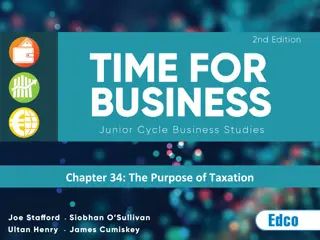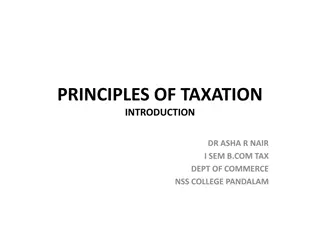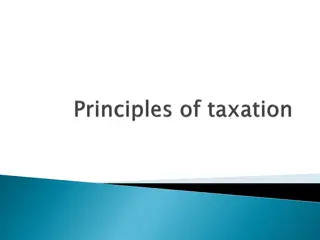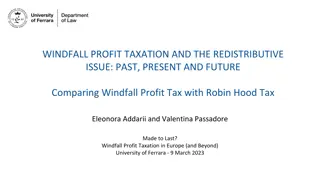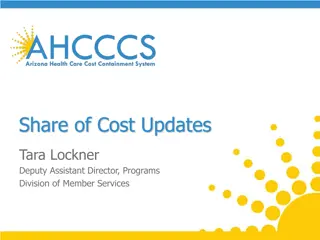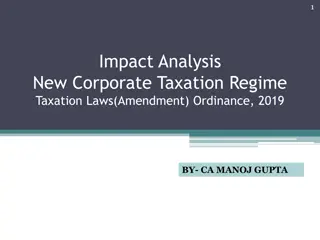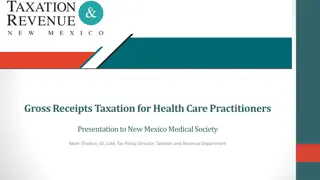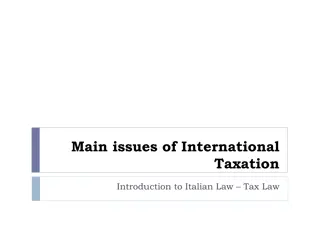Understanding Deductions in Taxation
Explore the essentials of tax deductions in Module 5, including how to calculate taxable income, lower taxable income plus income taxes, differentiate between Standard and Itemized Deductions, select the appropriate deduction for a client's return, and identify expenses covered by Itemized Deductions.
Download Presentation

Please find below an Image/Link to download the presentation.
The content on the website is provided AS IS for your information and personal use only. It may not be sold, licensed, or shared on other websites without obtaining consent from the author. Download presentation by click this link. If you encounter any issues during the download, it is possible that the publisher has removed the file from their server.
E N D
Presentation Transcript
Module 5: DEDUCTIONS Special thanks to: Cara Cardotti and Teresa Hinze for their contributions to this module.
By the end of this module you will Understand how the tax liability is calculated Understand the ways to lower one s taxable income and income taxes Understand the difference between the Standard and Itemized Deductions Understand how to determine which deduction should be applied to a client s return Understand what items/expenses are included with the Itemized Deduction
In this module The Tax Computation Standard Deduction Itemized Deductions
The Tax Computation A general overview
The Tax Computation Tax filers are not taxed on all of their income. Income that is considered taxable (and certain non-taxable income) must be reported on the 1040 but that does not mean that the income will be taxed. On the Form 1040, the lines for: Total Income Taxable Income Total Income - Adjustments = Adjusted Gross Income Adjusted Gross Income - Deductions = Taxable Income
Determining Taxable Income Step 1: Determine Total Income (this is not the same as Taxable Income ) Total Income = the taxable sum of the following: Wages Interest Dividends Capital gains Business Income Pensions Social Security Unemployment, etc. Total Income = line 9 = the sum of lines 1z + 2b + 3b + 4b + 5b + 6b + 7 + 8
Determining Taxable Income Step 2: Reduce Total Income to determine Taxable Income There are two taxable income reducing categories: Adjustments (Module 4): IRA deductions Student Loan Interest Self-Employment tax, etc. Total Income Adjustments = Adjusted Gross Income (AGI) Deductions Standard Itemized Adjusted Gross Income Deductions = Taxable Income Note: Non-refundable credits (Module 6) can reduce income tax after it is calculated.
Deductions Overview Deductions are subtracted from the Adjusted Gross Income (AGI) to result in the Taxable Income The taxable income is used to determine the tax. There are 2 types of Deductions Standard Itemized Only one of these two can be applied to a return Use the one with the higher value . UNLESS you re required to itemize your deductions! For example, MFS filers may be required to itemize . To obtain lowest Taxable Income value Don t sweat this! You got this!
Deductions Taxable Income Adjusted Gross Income (AGI) Choose Highest Value* Itemized Standard *unless required to itemize Taxable Income
Standard Deduction Standard Deduction - A dollar amount that reduces the amount of taxable income Varies according to filing status Additional standard deduction for individuals who are blind or age 65 or over You CANNOT take the standard deduction if you itemize deductions Individuals that qualify as someone's dependent generally cannot take the full standard deduction NOTE: Not all clients are eligible to take the Standard deduction If a married couple is filing separately and one spouse uses Itemized deductions then the other spouse must also use Itemized deductions If you are a nonresident or dual-status alien during the year you cannot take the standard deduction. See 4012 for special circumstances for nonresident aliens married to a US citizen or resident. See your 4012 for other less common cases.
Standard Deduction Values (2023 returns) Filing Status Standard Deduction Amount Single and MFS $13,850 MFJ and Qualifying Widow(er) $27,700 Head of Household $20,800 Additional standard deduction for 65+ and blind Filing Status: MFJ, Qualifying Widow(er) or MFS $1,500 for each taxpayer Filing Status: Single or Head of Household $1,850 An individual who qualifies as a dependent: Standard Deduction is the greater of $1,250 (if all income is unearned income) OR sum of $400 and individual s earned income (up to the standard deduction for their filing status) OR the Standard Deduction for their Filing Status if earned income is greater than the Standard Deduction
Itemized Deductions Schedule A Itemized Deductions Under current law, most VITA clients have lower federal taxable income using the standard deduction. Taxpayers with higher incomes or high mortgage interest expenses are more likely to benefit from federal itemized deductions. This training is focused on federal tax returns. Check with your VITA program, or state training resources to see if your state is one where clients can benefit from itemizing on the state return. Common itemizable expenses include: Medical and dental expenses Taxes paid (state & local income taxes, & property taxes) Home mortgage interest & points paid, Gifts to charity Certain miscellaneous deductions. Can include gambling losses and casualty and theft losses Check to make sure these are in scope! Standard Itemized If itemizable expenses are greater than the taxpayer s standard deduction it will probably be better to itemize.
Itemized Deduction Expenses What to include? Medical Expense Amount that is > 7.5% of AGI Include medical & dental expenses paid for all members of the household: Doctor & Dental bills Prescriptions Hospital bills Insurance premiums (health and long-term care) not subsidized by employers or covered by the APTC Mental health treatments Transportation for medical treatments And others (See 4012 and IRS Schedule A Instructions for limitations and additional allowable expenses) Taxes State sales or income tax (whichever is larger) Note: it is best practice to calculate the sales tax as it may be higher for low wage and non-working taxpayers (see 4012 or 1040 instructions for details on make the calculation) Local or foreign income taxes Foreign income taxes are generally out of scope except those on 1099-INT and 1099-DIV Real estate taxes Personal property taxes Beginning with tax year 2018, the total deduction for real estate tax, personal property taxes, and state income tax or sales tax is limited to $10,000.
Itemized Deduction Expenses What to include? Home mortgage interest (Form 1098) Limited to the 1st and 2nd home only Private Mortgage Insurance* For reverse mortgages, no interest until the loan is settled. Cash or non-cash donations to a qualified charitable organization Charitable deductions are limited by VITA scope Miscellaneous Deductions Gambling losses up to the amount of winnings Be careful not to deduct more gambling losses than reported as gambling winnings! These winnings are reported on W- 2G. Since TY2018 many miscellaneous deductions including union dues, investment expenses and unreimbursed employee expenses were eliminated BUT some work related expenses are allowed for Disabled Persons. Work related expenses are allowed for a Disabled Person only as well. Casualty and Theft Losses are Out of Scope for VITA! See your Publication 4012 for the complete list *NOTE: the ability to include Private Mortgage Insurance as a interest deduction changes from tax year to tax year. Make sure you check the tax law if you are not preparing a TY2023 return.
Interview About Deductions Start a discussion about Itemized Deductions with the client using the 13614-C, Part IV. The Interview Tips-Itemized Deductions are very helpful in guiding your discussion. Reminder: many clients will have qualifying Itemized Deductions; but may benefit more from the standard deduction. If the client is not making mortgage payments, it s very likely the standard deduction will be more beneficial. Check with your VITA program for tips on how detailed to get in this part of your client interview. For TY2023, there is no deduction for cash donations to charity unless the client itemizes.
Re-Cap Taxable Income Total Income Total Income Adjustments = Adjusted Gross Income Adjusted Gross Income Deductions = Taxable Income There are 2 types of Deductions Standard Itemized Only 1 of these two can be applied to a return Standard vs Itemized Deduction How to choose?? Use the one with the higher value . To obtain lowest Taxable Income value* *Unless the taxpayer is required to itemized! If the sum of the individual expenses paid by the client results in an amount that is greater than the Standard deduction amount, Itemize Deductions (Schedule A), using the sum of the individual expenses to reduce taxable income. The software will help calculate for you!
Additional Resources Publication 4012 IRS Tax Topic #551: Standard Deduction IRS Tax Topic #501: Should I Itemize? Up Next Module 6: Non-refundable Credits










